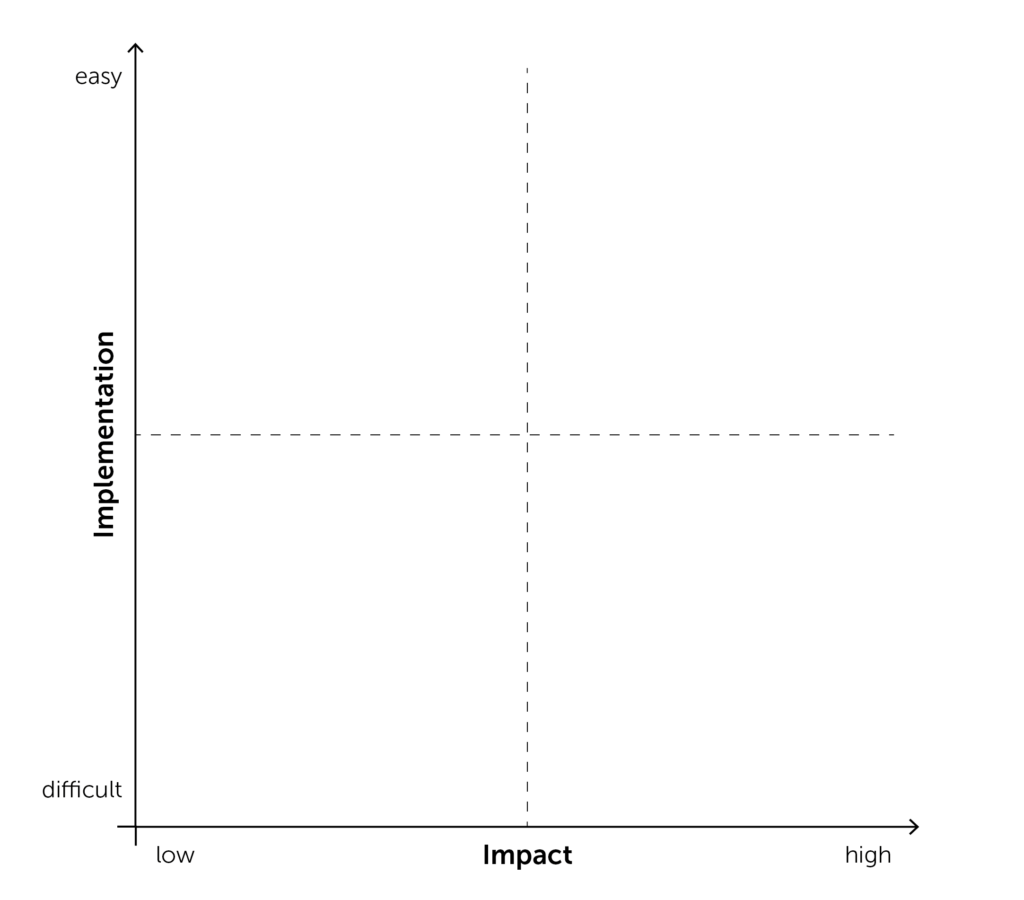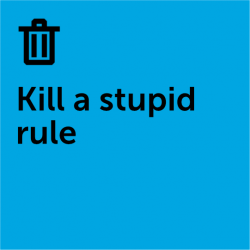Step by step instructions
Step 1: Preparation
Kill a Stupid Rule Matrix on flipchart/whiteboard:

Step 2: Brainstorming as a team or project group (15 min)
Each team member silently collects answers to the question: “If you could change or eliminate any rule in the organization which one would it be? Each rule is written on a separate card (sticky note).
Important: After collecting all the rules, first identify which rules are “red” and cannot be changed (e.g. legal regulations, safety precautions) and which are “green” and can be changed. If you are working on a digital whiteboard, you can colour the digital sticky notes accordingly.
Step 3: Analyze the impact
Now select those rules that you want to change (the green sticky notes) and assign them on the matrix.
First, only think about the x-axis. How much impact does this rule have? The rule cards are placed next to each other on the x-axis.
Step 4: Analyze the feasibility
Then think about how difficult it would be to change this rule. To do this, move the rules up on the y-axis without changing the position on the x-axis. In this discussion, pay attention to what implicit assumptions you are using when assessing the difficulty. Uncovering implicit assumptions works best by stating what stands in the way of implementation, even if they seem to be self-evident.
Step 5: Evaluate the matrix
With the previous steps you now have a prioritization of your rules:
- Those in the upper right quadrant are your “quick wins”: they have great influence and are easy to change.
- The rules in the lower right quadrant you can approach strategically with a bit of lead time, as it means more effort.
- You can take another look at the rules in the upper left quadrant: maybe there is one or two that have at least a little impact without much effort.
- Those at the bottom left you should probably not touch at all, as the effort is high and the influence is not significant.
Step 6: Next steps
As a group, define concrete next steps and responsibilities for the “stupid” rule that now has to go.
Step 7: Reflection
Take a moment to reflect on how it felt to approach the “holy grails”. Did you find it difficult or easy? What did this thought-provoking exercise trigger in you? Repeat this exercise at regular intervals and keep track of whether you succeeded in “killing” the rules you chose.
Conclusion:
You will be surprised how many rules come up that you did not even know were hindering the work in your team. Often it also becomes visible that the “rules” are not rules in the strict sense, but implicit assumptions and informal processes.
Inefficient administrative processes cost the German economy around 30 billion euros (2019). In an international comparison, German companies have the second worst productivity performance in administrative tasks. Between 2018 and 2019 alone, the time spent on administrative tasks increased by 5%. (Source: Vera Starker: The Focused Company. Endlich wieder konzentriert arbeiten!, p. 36, Rossberg Buckow, 2023.)
RELATED METHODS
Micro MovesStart, Stop, Continue





